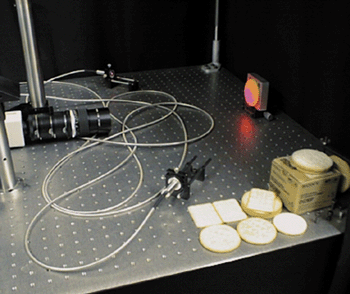Food manufacturers can increase their profits by using ever-more-sophisticated physics techniques, as Valerie Jamieson discovered at a recent conference on machine-vision systems.

Physicists know less about the temperature inside a soufflé than they do about the temperature of Venus, the late Nicholas Kurti once famously remarked. Yet the food industry uses a surprising variety of physics-based tools and techniques, including X-rays, lasers and spectroscopy, to inspect the quality of products ranging from basmati rice to sausage rolls.
Most producers visually inspect foodstuffs in the factory to identify and remove defective products and contaminants. After all, no one wants to find shards of metal in their baked beans, or stones in their sweetcorn. But visual inspection is also used to grade the quality of food, which adds value and allows producers to recover more of the end-product. For example, the ripest and best-looking tomatoes can command high prices, while the blemished and misshapen ones can be sold to make sauces or soups, rather than be thrown away. Last November physicists and retailers gathered at Woburn Abbey to discuss the latest inspection techniques at the UK Industrial Vision Association’s workshop on machine vision in the food and drink industry.
High standards matter to Jon Roe, a quality-development manager at Sainsbury’s, one of the largest supermarket chains in the UK with an annual turnover of £18bn. Roe explained that Sainsbury’s customers place more importance on high-quality produce than they do on low prices. But in order to maximize profits, food producers need to reject defective goods as early as possible in the production line.
Meaty problem
Some products – like rice and peas – can be inspected relatively easily by using automated optical-sorting machines, to look for defects such as insect damage and discolouration (see Physics sorts the wheat from the chaff Physics World June 2000 pp24-25). Other products, like fresh meat and fish, present greater challenges for machine-vision systems and currently must be inspected by hand. Roe urged physicists and engineers to design the next generation of systems that can recognize a “good” piece of meat by its colour, size and fat content. Moreover, these machines will have to be able to withstand the demands of factory life.
Indeed, meat and fish processing plants are harsh environments, as Mark Graves of Spectral Fusion Technologies in Birmingham discovered when he spent two years in a chicken factory in the Netherlands. Graves was developing an X-ray system to detect fragments of bone in fish and poultry fillets. He began by using off-the-shelf X-ray sources and detectors, similar to those found in baggage-inspection machines at airports. He soon found, however, that the chemicals and high-pressure water jets required to clean the system played havoc with the detectors, causing them to break down regularly. Moreover, the machines often failed to tell the difference between bones and thicker pieces of chicken flesh due to the relatively low contrast between the two materials.
Graves knew that a robust X-ray system dedicated to finding bones in chicken and fish was needed, and by 1995 he had founded Spectral Fusion Technologies (SFT) to develop a new machine called Bonescan.
Initially the company had a difficult job convincing the food industry to buy the machine because X-ray food-inspection systems had previously received a bad press. Graves recalls meeting a senior vice president of Tyson Foods, one of the largest meat producers in the world, at a poultry show in Atlanta in 1998. He told Graves: “X-ray inspection systems don’t work; they are inaccurate; they have too high a false-reject rate; they can’t be cleaned properly; we’ve tested them at great expense; you have nothing new to offer us – don’t waste our time. Stop calling us.” The meeting was over in 30 seconds.
But times have changed and the technology has improved. SFT has now sold 19 Bonescan machines, mostly in the US where companies fear being sued by consumers who choke on chicken bones.
So what makes Bonescan so successful? In a poultry plant, trays of filleted chicken breasts and thighs are scanned through the inspection system, which comprises a polychromatic X-ray source, filters and an array of pixellated photodiodes that have been tuned to specific parts of the X-ray spectrum. By using a range of X-ray energies, Graves and co-workers have greatly improved the contrast between flesh and bone. In particular, the absorption coefficients of the two materials differ significantly at low energies, thereby allowing defects to be revealed in detail (figure 1).
But to avoid confusing a bone with a thicker piece of meat, the researchers also have to determine the thickness of the portion at every point. They do this by exploiting the fact that the absorption coefficients of the two materials are similar at high energies and so combine images obtained at high and low energies. This combined view is then analysed by a neural network – a computer program that has previously been “trained” using thousands of images to distinguish between good fillets and ones that need to be de-boned again by hand.
Graves explains that Bonescan, which costs £250 000, can correctly identify any remaining bones 99% of the time, while the fraction of chicken breasts or thighs that it incorrectly rejects is less than 3%. However, he admits that the system has more difficulty spotting soft bloody bones, which have a similar absorption coefficient to flesh. The machine is also robust enough for factory use – it can be stripped down for cleaning in less than 20 seconds, it calibrates itself and it is simple to operate. Moreover, it can inspect an impressive 10 000 fillets every hour. In fact, Tyson Foods has completely changed its opinion and has now bought seven Bonescan machines.
Bread-and-butter physics
Image analysis is also having a big impact in the cereals industry, as physicist Martin Whitworth of the Campden and Chorleywood Food Research Association explained at the meeting. His company has developed a fast, non-destructive technique to measure the amount of bran in flour. The system, known as Branscan, allows millers to mix very pure white flour with flour of lower grade to produce an acceptable overall blend, thereby improving their cost margins.
Existing techniques involve destructive and time-consuming measurements of the mineral content or the colour of the flour. In some cases, the miller takes a sample from the production line, burns it in the lab and then analyses the residue. In other mills, the overall colour of the flour is inspected – a measurement that can take up to two minutes.
In contrast, Whitworth and co-workers have developed an on-line monitoring technique that exploits the fact that flour is pumped pneumatically to move it around the mill. A trapdoor in the duct automatically collects a small sample of flour directly from the pipeline. A series of lower-power light-emitting diodes illuminates the flour in the inspection area so that a camera can take a snapshot of the sample. Image-analysis software then searches for specks of bran, which are much larger and more irregular in shape than the flour, and computes the bran content before releasing the flour back into the pipeline. The whole process takes about 10 seconds, allowing millers to adjust the flour mixture in real time.
Whitworth’s group, together with Ricky Wildman and Qasim Saleem at Loughborough University in the UK, is also developing a laser-based technique to measure the strain in biscuits (figure 2). Most manufacturers package their biscuits shortly after baking. However, the non-uniform moisture content in freshly baked biscuits can lead to a build up of strain, which causes them to crack.
The researchers are monitoring exactly how this strain develops across a biscuit using electronic speckle pattern interferometry (ESPI) – a technique that is more commonly used in the automotive and aviation industry, as well as in art restoration (see Lasers in art conservation Physics World November 2001 pp37-42).
In ESPI, a laser beam is split into two: one of the beams is focused onto the biscuit, while the other beam is interfered with the reflected light. The resulting interference pattern is recorded in real time with a CCD camera and then subtracted from a reference image. So far, Whitworth and co-workers have detected strains of 10-5 and have started making measurements as a function of humidity. The results could eventually lead to improvements in the baking process, and fewer broken biscuits.
Appliance of science
Although machine-vision systems are not at the cutting-edge of physics research, it is clear that the food and drink industry offers some unique challenges for physicists. Transferring equipment from the lab and making sure it can operate almost continually in a factory environment is the real test. So next time you are enjoying a chicken burger or a chocolate biscuit, it is worth giving some thought to the physics that went into producing it.




